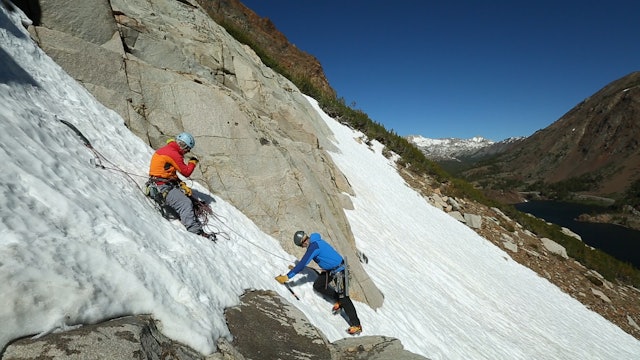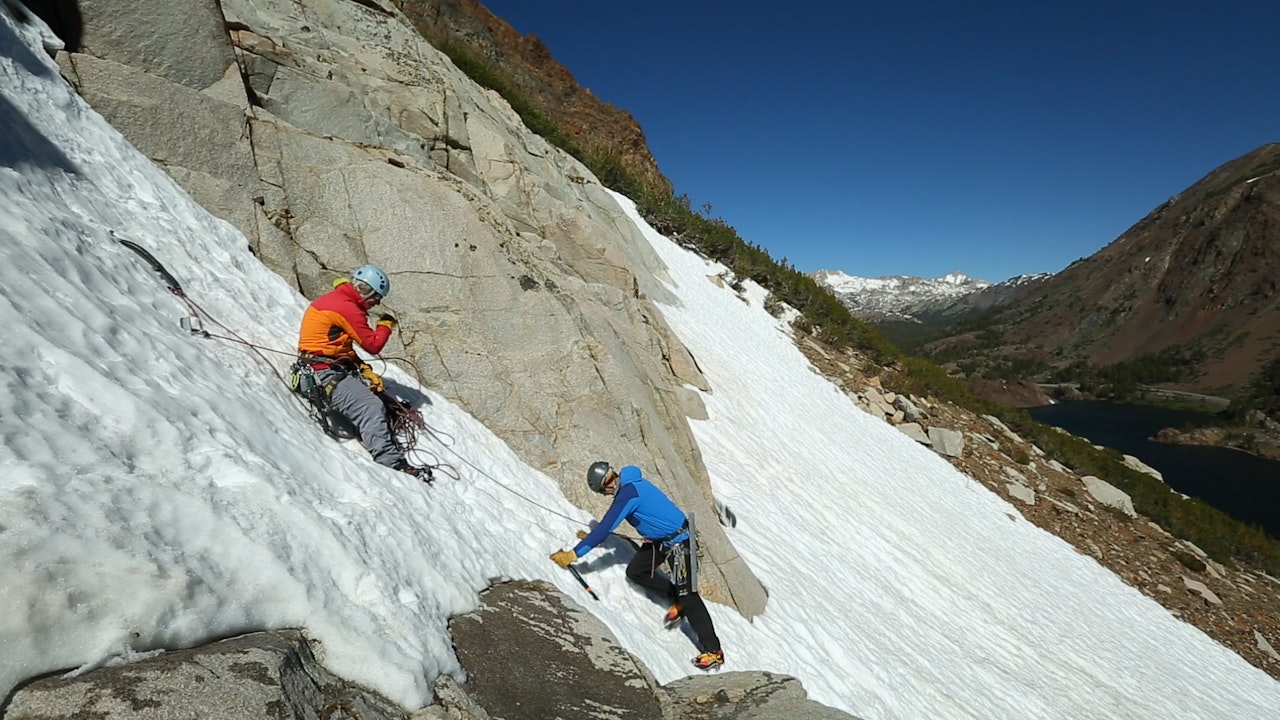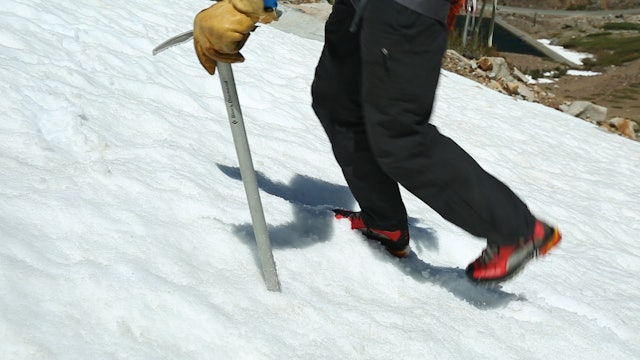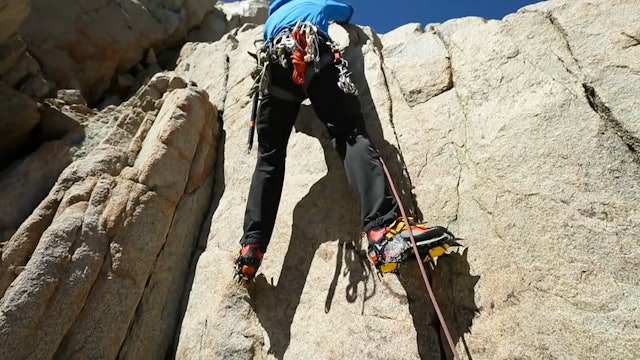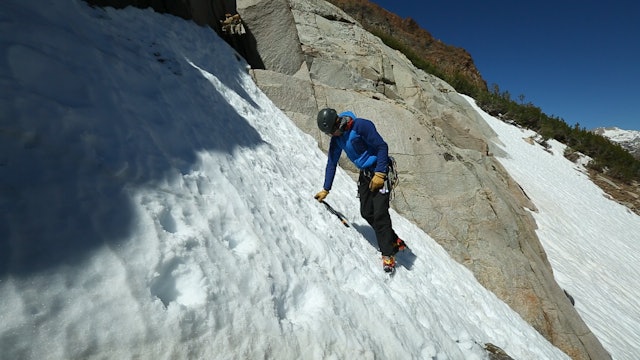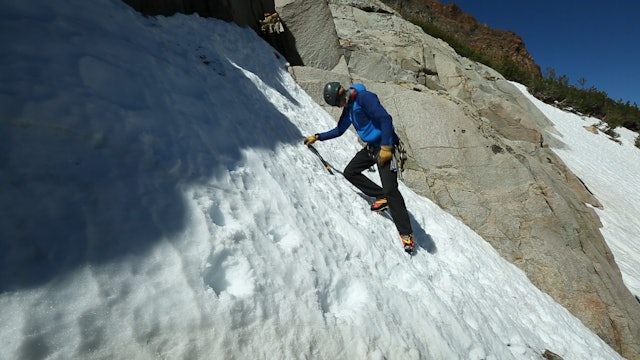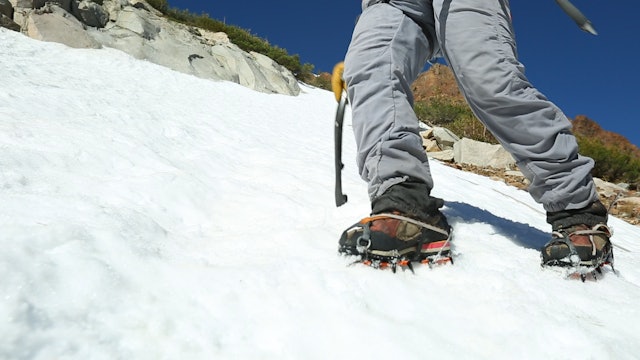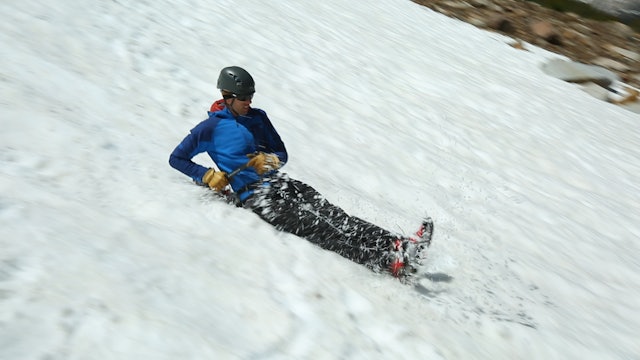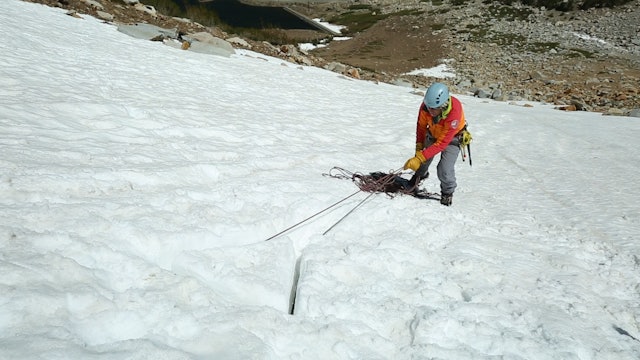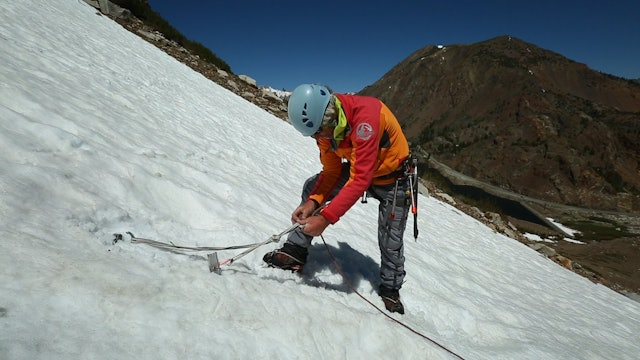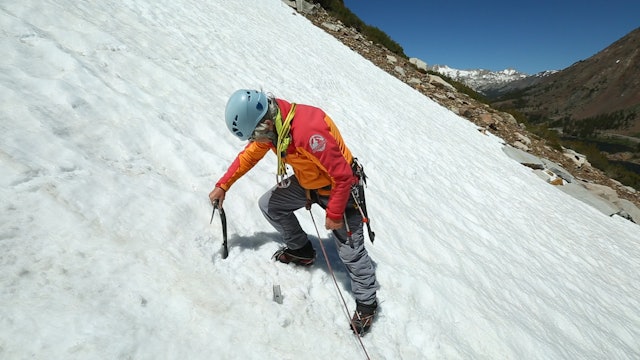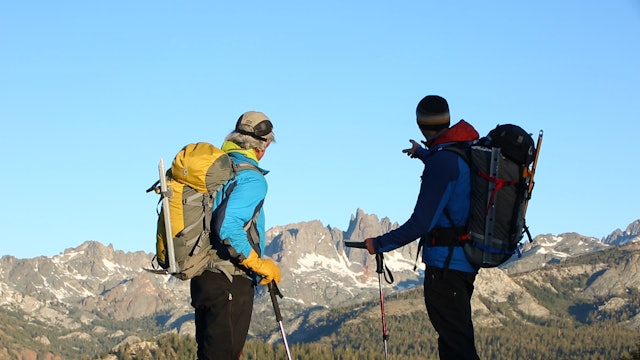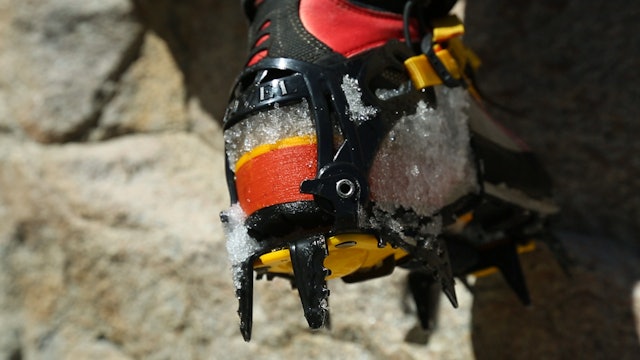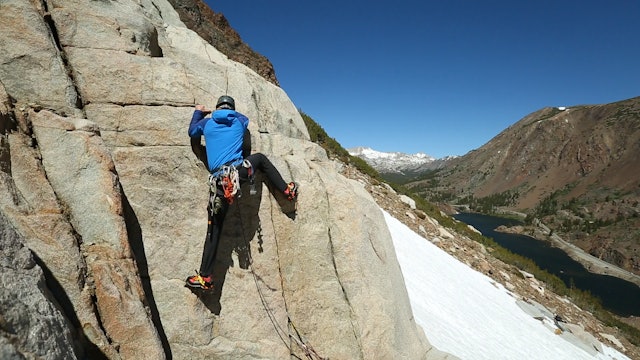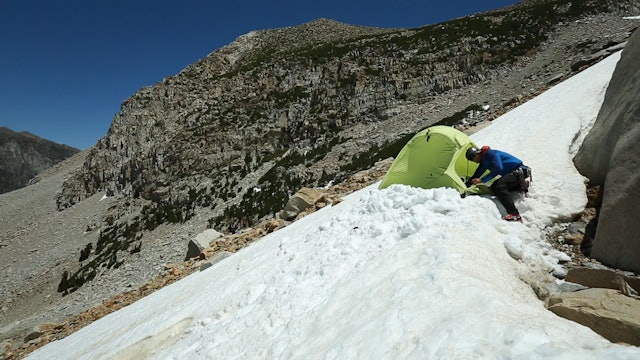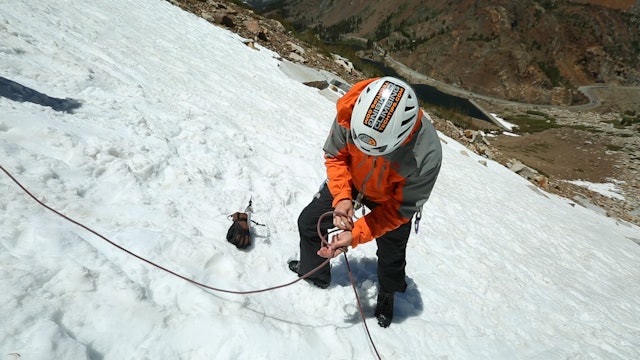Alpine & Mountaineering
Steeped in history, the concept of Alpine Climbing & Mountaineering conjures visions of big peaks with grand adventures. This category also factors in the harsh realities of long slogs and cold temps!
Several generations of climbers began with Alpinism and Mountaineering. Extended hikes in the mountains turned into technical outings and thus Alpine Climbing was born.
In this series we cover an assortment of mountain skills required for surviving high-altitude weather and navigating technical terrain. We suggest you become well-versed in our Basic & Intermediate Outdoor Climbing video series, as well as our Ice Climbing and Traditional Climbing videos.
Let’s get started! Our Alpine & Mountaineering Climbing video series is below. Be careful, and have fun!
Know & Go with ClimbingTechTips.com
Please remember, climbing is inherently dangerous. Climb at your own risk.
-
Alpine: 1. Ice Axe Positions
In this video we review considerations for ice axe positions. The ice axe is the symbol of mountaineering. When used correctly, it can be one of the most versatile tools a climber employs in the mountains.
There are many ways the ice axe is used and held to help climbers with ascending and de...
-
Alpine: 2. Crampon Selection & Use
In this video we discuss crampon selection and crampon use, specifically for alpine climbing and mountaineering. This video also touches on selecting crampons for ice climbing. First we will discuss the different types of crampons, and then what to consider when selecting appropriate spikes for y...
-
Alpine: 3. Kicking Steps - Duck Foot, Flat Foot & Front Pointing
In this video we show how to kick steps in the snow. When snow conditions are soft enough to allow your boots to penetrate the surface, kicking steps tends to be the most efficient and secure way to climb steep snow.
When kicking steps you will either have ski poles or an ice axe in one hand, ...
-
Alpine: 4. Snow Travel - Chopping Steps
In this video we look at how to chop steps for climbing snow.
There are times in the mountains when most of the terrain will be on rock, trails, and talus. This is typically late summer or in the autumn, or lower elevation alpine areas following a lean winter. Sometimes you may choose to leave...
-
Alpine: 5. Snow Travel - Duck Foot
In this video we look at the duck foot technique for climbing snow.
When ascending up a snow slope of moderate angle, the most efficient method may be the duck foot method. The French term for this is “pied en canard”. It is similar to the herringbone technique that a skier would do to ascend...
-
Alpine: 6. Snow Travel Considerations
Snow is an incredible medium on which to travel, and often provides efficient travel conditions. In this video, we look at various aspects of climbing on snow.
Perfect spring “corn” snow that is well consolidated and soft enough to take a boot kick or ski edge, or firmer snow that takes crampo...
-
Alpine: 7. Efficient Snow Travel
When getting into mountaineering, it is worth it to invest time in learning and practicing the most efficient stepping techniques. Mountains can be huge, and involve lots of steps. The more efficient you are with each one, the further you will be able to climb.
As the saying goes: how do you e...
-
Alpine: 8. Changing Directions in Snow
Let’s look at how to change directions when climbing steep snow slopes. When switchbacking up a steep snow slope, you will obviously have to change directions—multiple times!
Here are the steps for changing direction, while maintaining a self belay with the ice axe for security:
Step 1: Ta...
-
Alpine: 9. Crampon Anti-Balling Plates
In this video we discuss crampon anti-balling plates. Snow can stick to the bottom of your crampons, especially in wet snow conditions. After a few steps, you’ll feel like you’re walking on slippery (and heavy) platform shoes, and your sharp points will be useless.
One solution that manufactur...
-
Alpine: 10. Descending on Snow
In this video we look at descent techniques on snow. Investing time to become comfortable and efficient while descending snow helps you become faster on big mountain routes. People who ski or snowboard are likely familiar with a key component of the technique: keeping a confident, athletic positi...
-
Alpine: 11. The Self-Arrest
In this video we review the self-arrest technique, a way of stopping a slip and fall on steep snow. Self arresting involves using the ice axe as a brake when one has slipped down a snow slope, and is a tool that should be automatic for every mountaineer. It takes practice, and mastery is key.
...
-
Alpine: 12. How to Glissade
In this video we look at proper glissading technique. This is a fancy term for sliding down the snow; either standing or seated. Glissading can be a fun and quick way to descend snow. It can also create a dangerous situation, and has been the cause of numerous accidents.
A few considerations...
-
Alpine: 13. Snow Anchors - Creating a Bollard
In this video we build a snow bollard. This is a type of snow anchor that can be used for rappelling when you have no other anchor options. They are also great because you simply use the snow and your rope, and leave nothing behind.
Bollards can be time consuming to build and finicky to perfec...
-
Alpine: 14. Snow Anchors - Equalization
In this video we look at how to equalize snow anchors.
Building snow anchors follows many of the same principles as building rock anchors. The force placed on snow anchors tends to be less than on rock. The exception to this would be haul systems for crevasse rescue.
When building anchors ...
-
Alpine: 15. Snow Anchors - Using your Ice Axe
In this video we take a look at anchors using an ice axe. An ice axe can be used as an effective snow anchor, in a couple different ways.
Vertical Anchor - The first method involves pushing or driving the shaft down into the snow, to create a vertical anchor. The best orientation is to drive ...
-
Alpine: 16. Gear Considerations
In this video we look at gear for mountaineering and alpine climbing. Alpinism has become synonymous with concepts like “fast and light,” minimalism, and “speed is safety,” and conjures up images of small teams moving quickly in the mountains. With this in mind, the guiding philosophies for our g...
-
Alpine: 17. Selecting Alpine Boots
Selecting alpine boots is typically based on mountain objectives, plus conditions. Factors include weather, altitude, and terrain.
Here we look different styles and brands of popular alpine boots, with considerations for each category. Bear in mind that most of the respected alpine and mounta...
-
Alpine: 18. Selecting Ice Axes & Ics Tools
Here we depict different styles of ice axes and “ice tools”. Selection factors include specific climbing objectives, and the conditions one plans to encounter while in the mountains.
Main factors to consider when selecting ice axes or ice tools include:
- Conditions
- Firmness of the snow
... -
Alpine: 19. Clothing Considerations
How do you dress for all the possible conditions you might encounter on an alpine climbing mission? In this video, we dive into layering clothes for alpine pursuits. You’ll notice that the clothes work as a system based on layers, that pack easily, dry fast, and that you can add or remove based o...
-
Alpine: 20. Staying Dry and Warm
In this video we talk about staying dry and warm in the mountain environment. Specifically, we will address layering and eating food.
Layering Clothes:
As in most outdoor sports, layering for activity is essential. With alpinism, one moves from periods of high exertion (where you expend hug...
-
Alpine: 21. Food & Water Considerations
In this video we discuss food and water options for mountaineering.
People often default to dehydrated packaged meals, but they can take a very long time to rehydrate at higher elevations, and above 15,000 feet some companies say you will have to boil the meal for as long as 20 minutes.
Re... -
Alpine: 22. Base Camp Considerations
In this video we look at how to choose an alpine basecamp. When selecting a base camp area, there are a four main considerations:
1. Proximity to your objectives
2. Access to water
3. Sun exposure
4. Wind protectionAnd below are a few tips related to each of the four main consideratio...
-
Alpine: 23. Bivy Considerations
In this video we discuss bivying in the mountains. A bivy is a term for a simple camp set up, often using an ultralight tent or emergency shelter, for exposed and challenging routes, or in inclement weather.
Moving light and fast with no bivy gear can feel far more enjoyable. However it reduce...
-
Alpine: 24. Knot Considerations
In this video we discuss the knots we use in alpine environments. These are relatively simple knots, even though the terrain is complex. You don’t need to know a lot of fancy knots for alpine climbing. Basic rock climbing knots will suffice.
Knots for alpine climbing should be easy to untie—ev...
